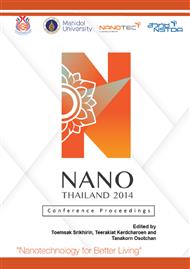p.223
p.227
p.231
p.237
p.242
p.246
p.251
p.255
p.260
Quality Control of Orange Juice Using Electronic Nose
Abstract:
Applications of electronic noses to classify the freshness of food and beverages by mimicking the olfactory perception are becoming widely recognized in food industries. For pasteurized orange juice, packaging and shelf-life are key factors for the quality control, which are generally inspected by the sensory stability and quality (odor, color, texture and taste) of the orange juice. An electronic nose based on five different commercial metal oxide gas sensors, a temperature sensor and a humidity sensor has been designed and constructed to examine the quality of orange juice as subjected to the fermentation process. The duration for a single measurement from an orange juice sample was approximately two minutes. The data acquisition of the voltage responses of the gas sensors were achieved via a microcontroller unit. The data classification was statistically analyzed by the “Principal Component Analysis (PCA)”. The Euclidean distance between two PCA groups was used as an indicator of ethanol concentration. The orange juice was laced with various concentrations of ethanol from 0.1 to 1.0% ethanol to simulate fermented orange juice at different stages. The objective was to characterize the freshness of orange juice by means of the ethanol level from the fermentation process. The results show a distinctive classification of the orange juice for an alcohol concentration lower than 0.1%. Thus the electronic nose offers a rapid, highly sensitive alternative for the quality control process.
Info:
Periodical:
Pages:
242-245
Citation:
Online since:
December 2015
Authors:
Price:
Сopyright:
© 2016 Trans Tech Publications Ltd. All Rights Reserved
Share:
Citation:


